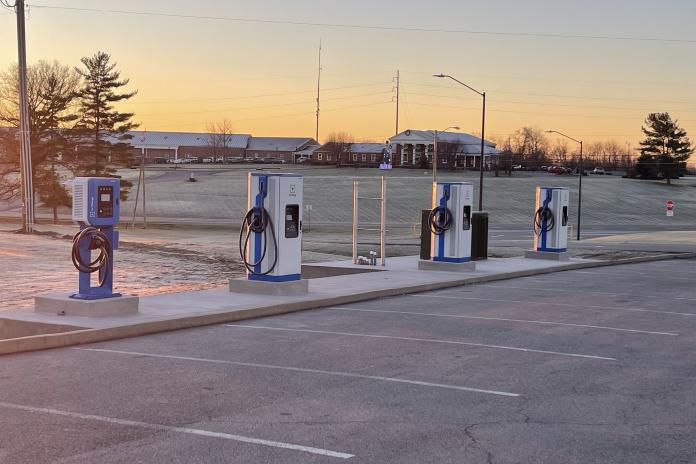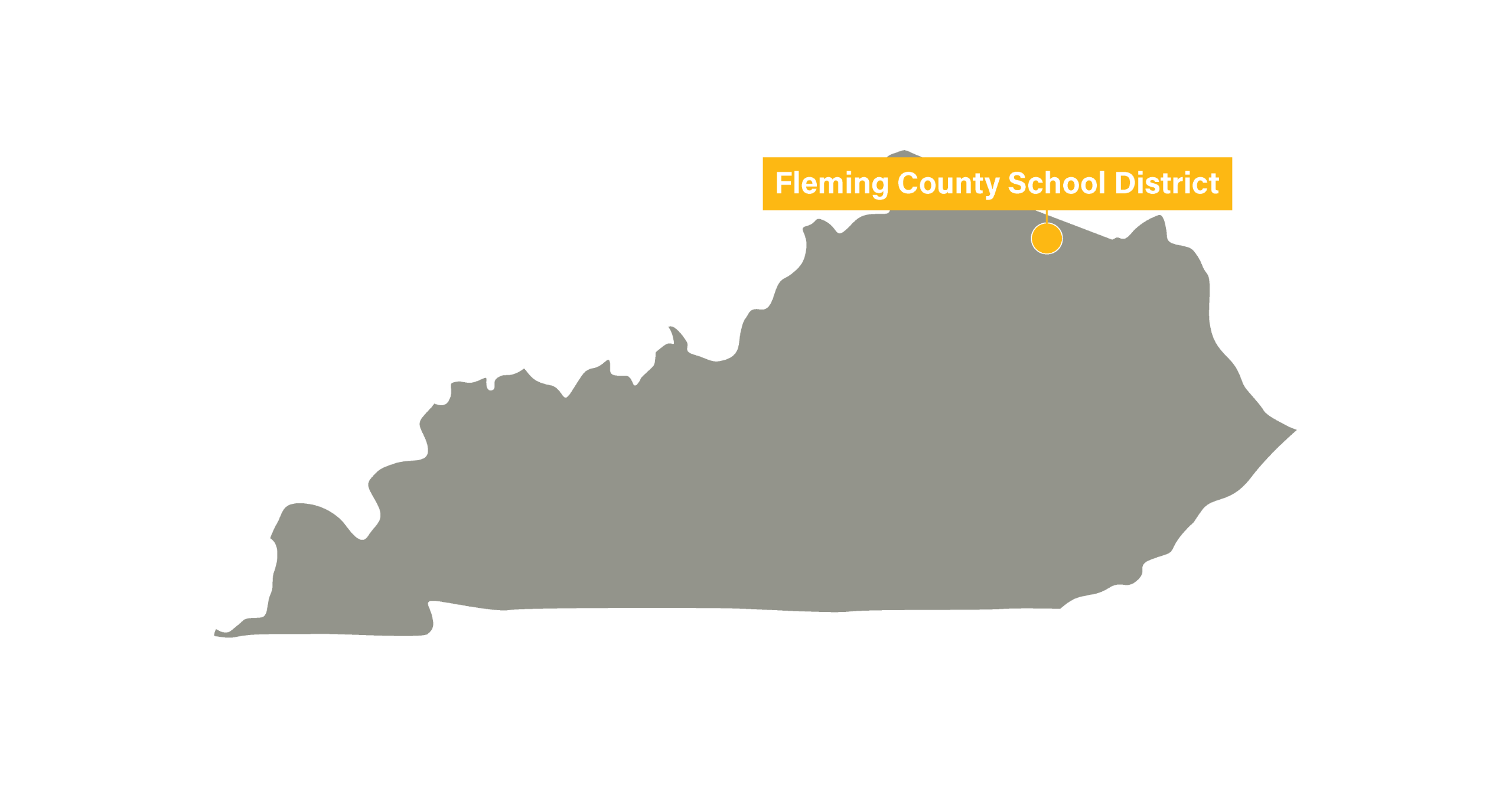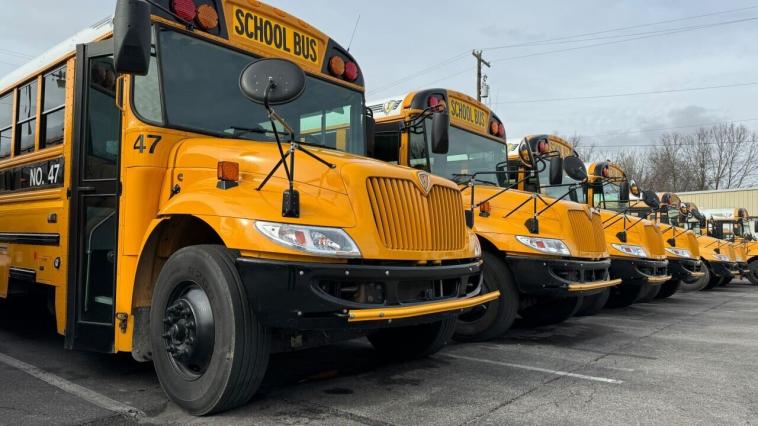How Cost Savings from Electric School Buses Enabled a Rural Kentucky School District to Increase Teacher Pay
Fleming County is saving hundreds of thousands of dollars with its new electric school buses, thanks to federal funding. That money’s going back into the classroom.

In the rural foothills of the Appalachian Mountains, Fleming County School District in Kentucky has become a pioneer in adopting electric school buses, thanks to grants and rebates from the U.S. Environmental Protection Agency’s (EPA) Clean School Bus Program (CSBP).
| Fleming County Schools | |
| Location | Fleming County, KY |
| Number of students | ~2,200 |
| Number of schools | 6 |
| Fleet size | 27 |
| Number of electric school buses in fleet | 24 |
Serving around 2,200 students across six schools, the district was awarded funding in two separate rounds of CSBP funding, ultimately receiving 24 electric school buses. According to Fleming County Schools Transportation Director Kerri Moran, this transition away from diesel-burning school buses would not have been possible without the financial support provided by the CSBP.
“The support from the CSBP has been a game-changer. It’s allowed us to bring these buses to our community.” - Transportation Director Kerri Moran
For districts with limited staffing and resources, the process of applying for some federal funding opportunities can be burdensome, but Moran noted that the CSBP application was surprisingly accessible for her district.
The district felt well-prepared, thanks in part to the relevant operational data —such as idle times and how far each bus traveled annually —that Superintendent Brian Creasman had already been gathering. Support from partner organizations including the Electric School Bus Initiative also helped streamline their transition to electric school buses.
Why Fleming County Schools chose electric school buses
Fleming County’s aging diesel-burning school bus fleet had become a financial and operational burden. Maintaining diesel burning school buses was costing the district upwards of $10,000 annually per vehicle for maintenance alone to ensure they remained safe for students. So, when the district learned about the funding the CSBP offered, they looked at how it would impact their budget. With funding fully covering the upfront cost of the electric school bus, they saw that the fuel and maintenance savings would be a net positive for the district’s finances.

Beyond the maintenance costs, the district was spending thousands of dollars on diesel fuel, at a rate of approximately $0.60 per mile. Now, with their new electric school buses, they pay just $0.12 per mile for energy, an 80% per mile cost savings.
As a rural and lower income district, Fleming County Schools applied for CSBP funding as a priority school district in the first and second round of the program. This allowed the district to access higher levels of funding and have a large fleet upgrade with 100% of the costs covered.
With the savings the district has seen from the electric school buses, they have been able to raise wages by 4% and reinvest in classroom resources.
What’s the latest?
Today, Fleming County Schools has seven electric school buses on the road with 17 more on the way, and they’re already seeing major cost savings. Initial projections show monthly fuel savings of $12,000, and that figure will increase to $17,000 as more electric school buses are deployed.
Driven by a broader commitment to sustainability and cost savings, Fleming County Schools has also benefited from its solar panels and receives credits from its utility company, Fleming Mason, for electricity generated. Together, the savings from electric school buses and solar power are being reinvested back into the classroom and helping to fund a district-wide teacher pay increase.

Operationally, the district reports that their electric school buses perform extremely well on longer and hilly routes —even outperforming diesel-burning school buses in Fleming County’s hilly terrain, based on testimonies from the drivers.
In fact, Moran notes that their electric school buses “run twice before we need them charged” and “take a hill a whole lot better than a diesel bus.”
Thanks to regenerative braking capabilities, one Fleming County Schools driver found that the battery on his electric school bus had gone from 77% charged at the start of the route to 82% charged when he returned. While there was initial skepticism from the drivers, the feedback now is that the electric school buses work extremely well for the district and even make the bus drivers feel healthier.
“The buses handle steep inclines easily,” Creasman said. “We were worried about hills, but they’ve exceeded expectations.”
Not only do the electric school buses offer a quieter and smoother ride for passengers, but Creasman notes the safer and more enjoyable bus dismissal process, saying that “it’s nice not getting exhaust blown in my face.”
“This transition isn’t just about the buses; it’s about setting an example for our students and the broader community,” Creasman said.
“The buses handle steep incline easily. We were worried about hills, but they’ve exceeded expectations.” - Superintendent Brian Creasman
But for Fleming County Schools and many other rural school districts, this ability to protect students and staff from diesel exhaust pollution wouldn’t have been possible without federal support. Thanks to CSBP funding, schools like those in Fleming County are saving money and supporting student health with clean, reliable electric school buses.
Now, Fleming County School projects that their transition to electric school buses will save the district more than $600,000 annually, through diesel and operational savings, once all 24 electric school buses are on the road in the next 10 years, and the district is already exploring further sustainable infrastructure developments, such as a solar-powered bus garage, through their strong partnership with their electric utility.
Once all 24 electric school buses are on the road, Fleming County projects annual cost savings of more than $600,000.
Advice for other school districts: “Just go for it!”
Ultimately, Moran and Creasman say that other school districts should apply for funding and transition to electric school buses.
“Just go for it!” Moran said.
They also encourage all school districts to do their research and build data collection systems preemptively. Additionally, Moran urges districts to build relationships with charging companies and suppliers before applying to make sure that there are minimal delays in charging infrastructure installation. Without strong relationships with charging companies, school districts “may wait 12 to 18 months for the chargers,” Creasman said, due to high demand for the chargers.
Fleming County Schools’ transition to electric school buses highlights how federal funding can drive sustainable innovation in rural communities. By prioritizing rural districts, EPA’s Clean School Bus Program has provided Fleming County with access to new technology that not only reduced operational costs but also protects student health and improves air quality.
“The support from the CSBP has been a game-changer. It’s allowed us to bring these buses to our community,” Moran said.
The district’s experience serves as a model for other rural districts, demonstrating how thoughtful planning, strong partnerships and the use of funding opportunities can make a clean ride to school accessible for students in every corner of the country.